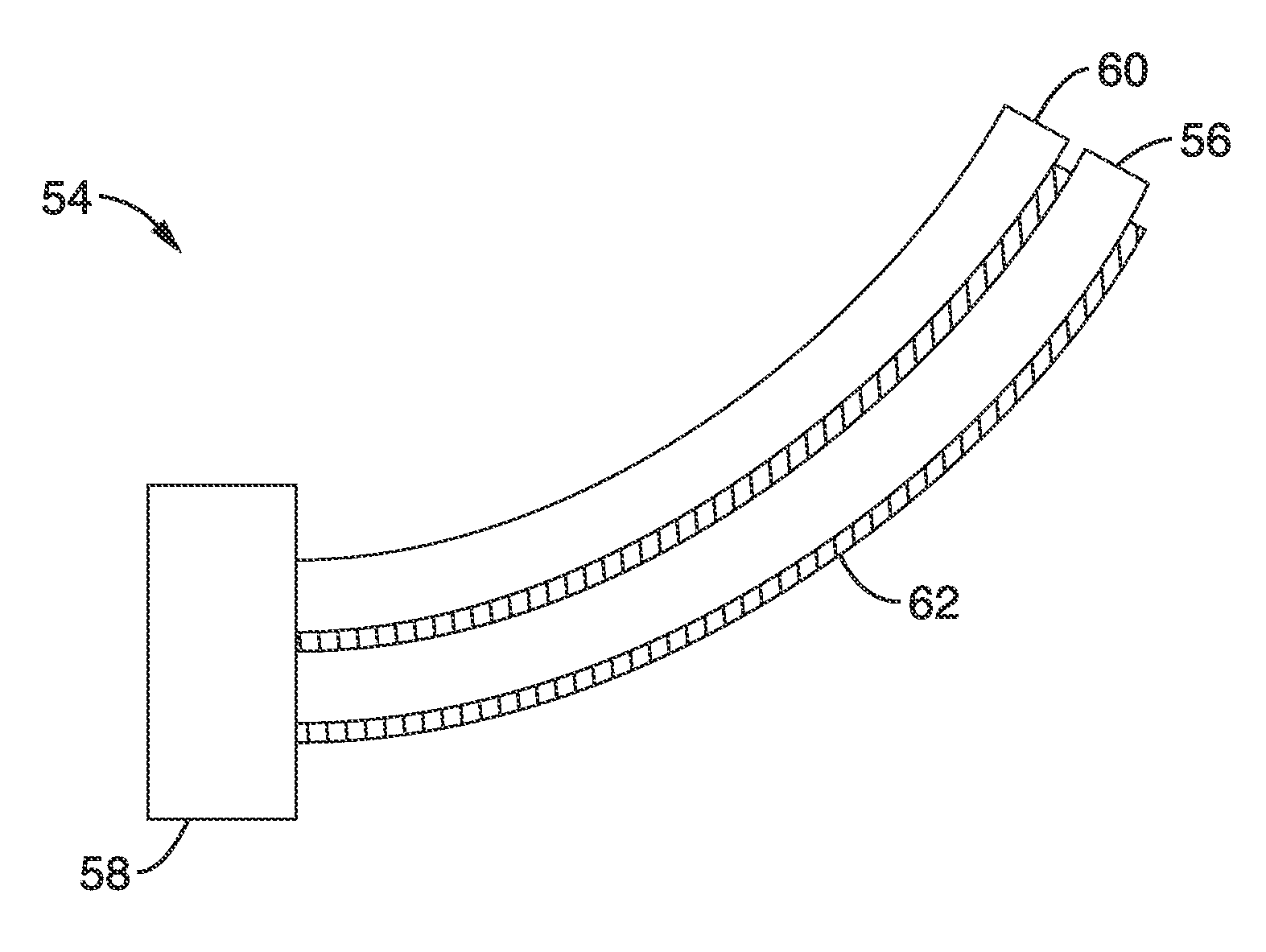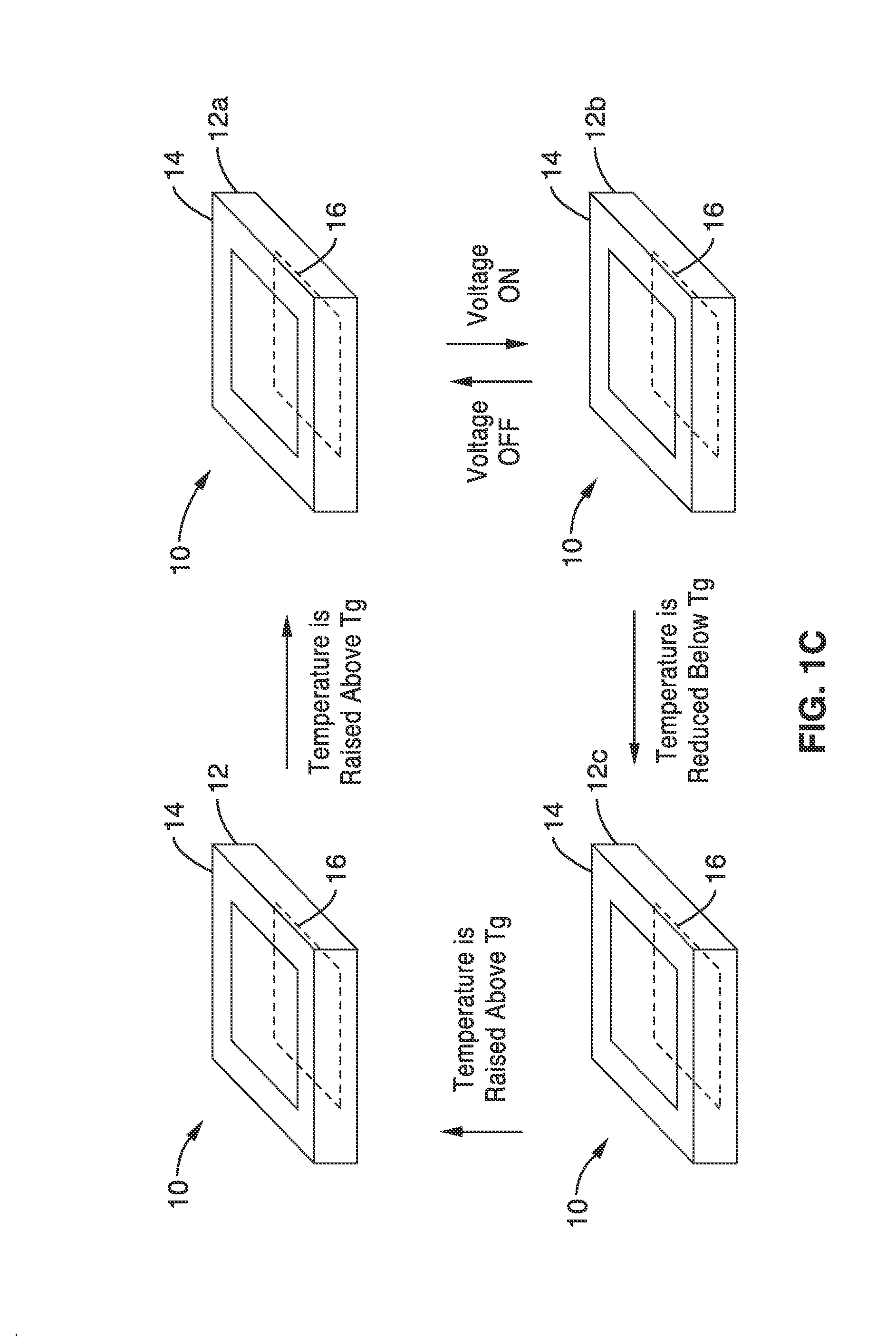Bistable electroactive polymers
a polymer and electroactive technology, applied in the field of electroactive polymers, can solve the problems of inconvenient application requirements, inability to obtain a larger number of or gradually deformed shapes, and many electric actuator technologies such as electromagnetic motors and solenoids are not suitable for applications. , to achieve the effect of restoring its rigidity
- Summary
- Abstract
- Description
- Claims
- Application Information
AI Technical Summary
Benefits of technology
Problems solved by technology
Method used
Image
Examples
example 1
[0132]In order to demonstrate the functionality of the structures and methods, a bistable electroactive polymer was produced with 0.5 grams of photoinitiator dissolved in 100 g tertbutyl acrylate. The mixture was polymerized under UV irradiation (100 W UV lamp, 15 cm distance) for 10 minutes to produce a clear and rigid solid product of poly tertbutyl acrylate. Poly tertbutyl acrylate films were obtained first by casting its toluene solution (−5 wt %) onto a cleaned and leveled glass substrate. The film was left to stand until the solvent was fully dried. The film was then put into 70° C. oven and annealed for 12 hrs. The polymer film was soaked into deionized water for 1 hour and peeled off from the glass substrate. The peeled off film was dried at room temperature in a vacuum oven for 24 hours.
[0133]Thermal annealing was found to be desirable to enhance the mechanical strength of the polymer films. The film was very soft without thermal treatment. It was also found the thermal ann...
example 2
[0136]Another demonstration of the functionality and application of bistable electroactive polymers (BSEP), Poly (tert-butylacrylate)(PTBA), a rigid thermoplastic at ambient conditions, was synthesized through UV initiated free-radical polymerization. The resulting polymer had an average molecular weight Mn of 120 000 daltons and polydispersity of 4.2, determined by gel permeation chromatography using a poly(methyl methacrylate) standard. Thin films were casted from solutions of PTBA in toluene followed by annealing at 70° C. for 12 hours. The annealed PTBA has a storage modulus of 1.5 GPa, a loss factor tan δ of 0.03 at 30° C. At 70° C., the storage modulus is 0.42 MPa with a loss factor tan δ of 0.8.
[0137]Diaphragm actuators were fabricated using 30 μm thick PTBA films. Conductive carbon grease was used to form the compliant electrodes. The PTBA film was placed on a diaphragm chamber. A rigid plastic frame was placed on top of the polymer film to define the circular active area wi...
example 3
[0140]To demonstrate the application of the bistable electroactive polymers to embossing, poly(tert-butyl acrylate) was cut into small pieces and dissolved in toluene to prepare a solution containing 20% by weight of the polymer. The solution was poured onto a sheet glass with a cleaned surface. After the solvent was evaporated in air, the polymer film coated on the glass was soaked in DI water to peel the film off of the glass. The dried film had a thickness of 340 μm. The film was then pre-stretched biaxially to a final thickness of 50 μm while it was heated at 80° C. For embossing, a plexiglass plate was drilled with φ2 (mm diameter) to create surface dimples. A steel ball of φ2 and φ1.5 was placed in each dimple. The resulting structure, the embossing mold, was cleaned with acetone. The pre-stretched poly(tert-butyl acrylate) film was laminated on the mold at 80° C. Then a 250 μm thick silicone elastomer film, a VHB 4910 adhesive tape, and an aluminum plate were successively pla...
PUM
 Login to View More
Login to View More Abstract
Description
Claims
Application Information
 Login to View More
Login to View More - R&D
- Intellectual Property
- Life Sciences
- Materials
- Tech Scout
- Unparalleled Data Quality
- Higher Quality Content
- 60% Fewer Hallucinations
Browse by: Latest US Patents, China's latest patents, Technical Efficacy Thesaurus, Application Domain, Technology Topic, Popular Technical Reports.
© 2025 PatSnap. All rights reserved.Legal|Privacy policy|Modern Slavery Act Transparency Statement|Sitemap|About US| Contact US: help@patsnap.com



